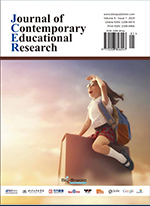Abstract
Language and culture are closely related, and understanding the cultural knowledge embedded in the process of language learning is an important goal of English teaching in colleges and universities. At present, the dissemination of Chinese culture in English teaching in colleges and universities is lacking, which affects the improvement of students’ intercultural communication skills. In order to effectively solve such problems, we need to take effective measures to disseminate Chinese culture by combining teaching content and students’ characteristics. This paper summarizes the problems of Chinese culture dissemination in English teaching in colleges and universities, and explores effective countermeasures and teaching considerations, hoping to provide teachers with valuable guidelines.
References
Dong Y, 2023, Exploring the Status Quo and Countermeasures of Chinese Cultural Aphasia in English Education in China’s Colleges and Universities. Journal of Hubei Open Vocational College, 36(6): 31–33.
Meng M, 2023, Research on “Chinese Cultural Aphasia” and Its Response in English Teaching in Colleges and Universities Under the Background of New Liberal Arts. Modern Vocational Education, 2023(21): 165–168.
Liao Y, Xiao S, 2023, Exploring the Strategies of Integrating Chinese Traditional Culture into English Translation Teaching in Colleges and Universities. Overseas English, 2023(17): 108–110.
Chen Z, 2023, Research on the Path of Integrating Chinese Traditional Culture Education into English Teaching in Colleges and Universities Under the Background of Cultural Strength. Engineering Technology Research, 8(2): 136–139.
Mao H, 2022, Research Status of Chinese Culture Infiltration into College English Teaching Under the Perspective of Intercultural Communication. Modern English, 2022(5): 104–107.
Li Q, 2022, A Study on the Status Quo and Countermeasures of Chinese Cultural Aphasia in English Education in Colleges and Universities in China. Journal of Heihe College, 13(10): 30–32.
Li Y, 2022, Research on the Integration of Local Culture and Chinese Culture Curriculum for English Majors in Colleges and Universities -- Taking Mianyang Culture as an Example. PR World, 2022(15): 103–105.
Liang J, 2022, A Study on the Status Quo of “Chinese Cultural Aphasia” in English Education in China’s Colleges and Universities. English Square (Lower Lunar), 2022(3): 93–95.
Chen F, 2022, Chinese Cultural Aphasia and Intercultural Education in Colleges and Universities. Journal of Yanbian College of Education, 36(5): 55–57.
Lai S, 2022, Discussion on Strategies of Promoting Chinese Traditional Culture in English Teaching in Colleges and Universities. Affective Reading, 2022(17): 72–74.
Liu B, Hu Y, 2023, Discussion on the Curriculum Design of Integrating Chinese Culture Theme Education in the Whole Stage of English Speech in Colleges and Universities--Taking the Culture of Imperial Examination as an Example. Modern English, 2023(9): 1–4.
Sun L, 2023, Research on Chinese Cultural Influence in English Teaching in Colleges and Universities Under the Background of Cultural Confidence. Scientific Counseling, 2023(1): 175–177.
Xu J, Xu Z, 2021, The Inheritance and Development of Chinese Culture in English Courses of Colleges and Universities in the New Era. Education and Teaching Forum, 2021(18): 70–71.
Lu Q, 2021, Analysis of “Chinese Cultural Aphasia” in English Education in Colleges and Universities from the Perspective of Cultural Co-Nucleation. Science and Education Magazine-Electronic Edition (Middle), 2021(3): 253–254.
Wang Q, 2020, Exploring the Supply-Side Reform of English Culture Teaching in Colleges and Universities - Based on the Perspective of English Learners’ Chinese Cultural Identity. Heilongjiang Education (Higher Education Research and Evaluation Edition), 2020(2): 55–59.
